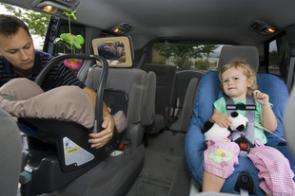Scientist Seeks to Improve Car Seat Safety for Children

Chris Sherwood studies what happens to children in car crashes. According to the National Center for Health Statistics, car crashes are the leading cause of death for children from 2 to 14 years old. In 2003, there were 2,136 children aged 2-14 who were killed in car accidents in the United States. And there were another 220,000 children in that age group who suffered injuries while riding in vehicles involved in accidents.
But the good news is that “restraint systems, when used properly, work,” said Sherwood, a research scientist in the Center for Applied Biomechanics at the University of Virginia. Restraint systems he has studied include rear-facing infants’ seats, forward-facing children’s seats, children’s booster seats and adult shoulder-belt systems for older children.
Sherwood leads a team of researchers at the center who are studying the factors that allow child restraints to better protect children in car crashes. In particular, they are examining the effectiveness of different child-restraint design components and orientations, i.e., rear facing vs. forward facing. The knowledge they gain eventually will enable manufacturers to make safer products.
Sherwood’s lab at the Center for Applied Biomechanics — operated jointly by the University’s School of Engineering and Applied Science and its School of Medicine — conducts a series of experiments using crash dummies that simulate 1-year-old and 3-year-old children. The experiments involve sending the dummies, strapped into various car seats, on a “sled” that shoots along a 66-foot-long track at 30 miles per hour until it slams into a barrier. (These experimental crashes take place in less than 1/10th of a second.) The displacement of the dummy’s body at the moment of impact is captured on high-speed video. Other information, such as the force of impact on different parts of the dummies’ bodies, particularly the head, is recorded by attached sensors and transmitted to a nearby computer for data storage and analysis.
The information Sherwood gathers through his crash dummy experiments is not only used in direct comparisons of results from different types of child restraints, it is also incorporated into computer models. The goal is to fine-tune the computer models so that they draw as accurate a picture as possible of what happens to a child’s body in a car accident. The “improved” computer models can then be used by the manufacturer of a child crash dummy to create a more lifelike or “biofidelic” dummy, which in turn can be used by car seat manufacturers to make the safest child car seats possible.
While Sherwood’s research will continue for another year, several preliminary results have emerged and will be featured in articles Sherwood and his team are currently submitting to scientific journals. These findings include:
• The National Highway Traffic Safety Administration currently recommends that parents switch their children from rear-facing car seats to forward-facing car seats when the children reach 1 year and 20 pounds. But in Sweden, families tend to wait until the children are 3 or 4 years old to switch them to seats that face forward. Sherwood’s review of U.S. data suggests that the rear-facing restraints result in lower injury rates. Revising U.S. recommendations to more closely resemble those used in Sweden could reduce the rate of injury and mortality of U.S. children in car accidents by more than 50 percent.
• Although NHTSA recommends that all young children ride in back seats, this is not possible in all vehicles, such as pick-up trucks that have no rear seats. Children in rear-facing seats strapped into the front seat of pick-up trucks are vulnerable to head injuries when there is a gap between their car seats and the dashboard. In a crash, the child restraints undergo significant movement that can result in the restraint slamming against the dashboard, an impact that is communicated to the child’s head. It is safer for these children when their car seats are installed touching the dashboard and eliminating that gap. NOTE: No children should be placed in a seat with an active airbag.
• Although it is well established that using an upper tether in forward- facing child restraints improves their effectiveness, a recent study quantified the benefit of using these upper tethers. In addition to reducing injuries, the tethers are crucial for reducing the chance of children’s heads striking the seats located in front of them.
• Car seats that are more rigidly attached to the vehicle show a lower incidence of injuries. New design components that are becoming popular in Europe, such as a supporting rod or leg that rests on the floor of the car, move less in the event of a crash and protect children against injury more effectively than car seats attached in other ways that allow more movement.
Source: University of Virginia





















